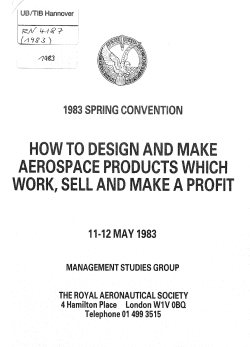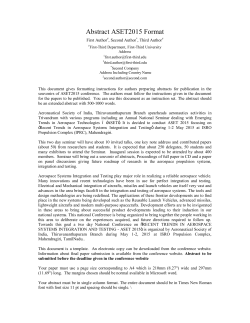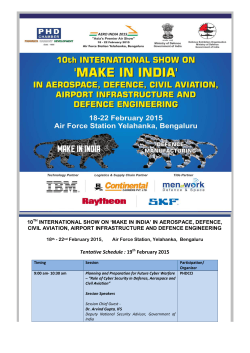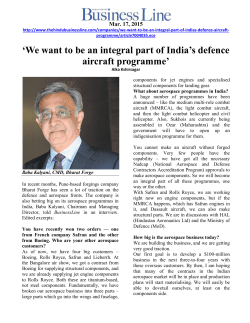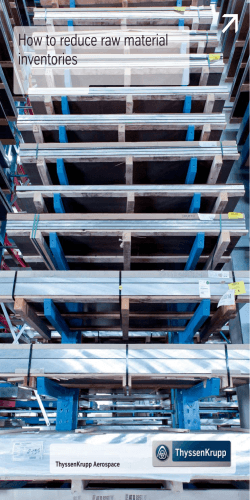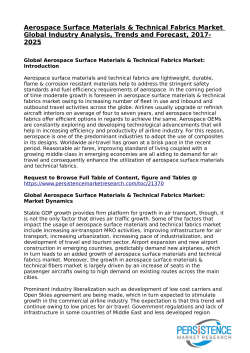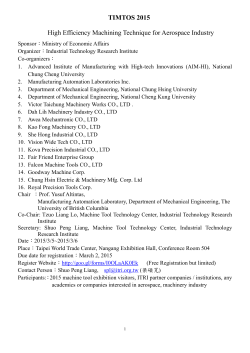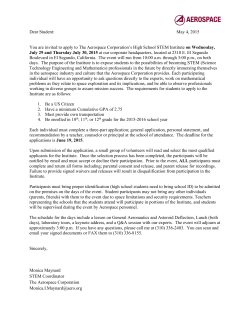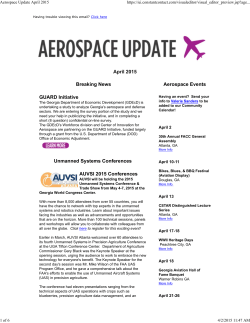
Document 204899
A6 Business June 3 – 9, 2010 The Epoch Times Trade Imbalance: Western Companies Losing Know-How to China SOCIAL NEWS: A snapshot of the social media site Twitter taken earlier this year. Consumers’ first source of news is often from a social media platform such as Twitter. LOIC VENANCE/AFP/Getty Images CHINA Continued from A1 Social Media and Consumers By ADELE LASSERE COMPETITOR: This picture taken last December in Marignane, France, shows the new helicopter EC175 of Eurocopter, a subsidiary company of global aerospace and defense company EADS, manufactured in cooperation with Aviation Industry Corp of China (AVIC). The aerospace industry has quickly grown in China and is no longer in its infancy, thanks to joint ventures such as this one. ANNE-CHRISTINE POUJOULAT/AFP/Getty Images United States in world markets. He referred to Japan as an example. The Japanese used the same techniques as the Chinese use today, namely replication and reverse engineering. At the time, no one would have believed the rise of Japan in the world’s commercial markets. Yet within a few years, Japan became a major competitor, and America lost much ground in world markets. Global companies claim that China has a long way to go to be able to compete effectively with the United States. But according to Herrnstadt, “Skeptics made the same argument years ago with respect to Japan, only to see the ‘made in Japan’ label become sought after by consumers who believed it represented high quality, technologically advanced goods.” China the Competitor China’s aviation manufacturing industry has grown out of infancy. As of today, there are 200 firms that produce almost every part needed in the production of aerospace products, including aircraft engines, aircraft bodies, and helicopters. Two of China’s leading aerospace companies, China Aviation Industry Corporation I (AVIC I), and AVIC II, together employ 491,000 people. Companies forming joint ventures in China include Airbus, Boeing, and Eurocopter. United Airlines has contracted China to perform maintenance for 52 of its Boeing 777s and 24 of its B747 commercial aircrafts. China subsidizes its aerospace and civil aircraft industry, but the extent is not known. In her testimony before the commission, Mary Saunders, deputy assistant secretary for the Manufacturing International Trade Administration, aired concerns about China’s connections between civil and military Adele Lassere is a marketing/advertising consultant with 20+ years experience, freelance writer and soon to be published author of “Elements of Buying: An Advertising Reference Guide for Business Owners.” Contact: [email protected] 4 TM Suggested Solution Learn from your mistakes Presented By 5F 405 Fw wy y Irvine Auto Center ine Ce est r. rD nte 16 Auto Center Drive, Irvine, CA 92618 949.830.7000 - www.fladeboehonda.com Located in the irvine Auto Center Irv 1-800-504-9592 manufacturing firms and the lack of transparency on the support of such industries. Herrnstadt quoted an Airbus representative as stating that the “A320 assembled in China unquestionably demonstrated the same quality and performance as those assembled and delivered in Hamburg or Toulouse,” which shows clearly that China’s aerospace industry is not in its infancy, but has caught up rather quickly to the West. In 1985, a joint venture between a Chinese company and McDonnell Douglas experienced “apparent lapses in the process, including the transfer of a commercial machine tool technology to a Chinese firm by McDonnell Douglas which was apparently diverted to a Chinese plant that manufactures military aircraft and cruise missile components,” Herrnstadt quoted the U.S. Government Accounting Office. Yep, there sure are a lot of social media advertising choices out there. So much so that it’s a wonder if anyone really uses these vehicles that much. Well, let’s set the record straight. Consumers have embraced and in many cases could be seen as obsessed with a variety of social media platforms. They can’t live without them! Consumers not only use Twitter and check Facebook regularly. In many cases, they will use these platforms before going to bed or when they first wake up. Therefore, their first consumption of news is from a social platform. These consumers will also use these social platforms many hours throughout the day. This is especially true with those users under 25 years old. Additionally, if these users own an iPhone, they have a higher propensity to constantly engage these platforms from a variety of locations traveled in the course of their day. Remember that younger users will always consume more of such social platforms. These users consider these platforms a part of their lifestyle. What about message interruption? Well, believe it or not, younger social platform users don’t mind a Tweet or Facebook message interrupting them during the course of a day. Of course, older social platform users do not quite have the same tolerance level as their younger counterparts. As for all forms of online advertising, social platforms offer an opportunity to have an extended dialogue with consumers who can become “brand ambassadors.” A “brand ambassador” makes recommendations, validates, and in some cases can nullify a product offering to their friends and family. This is what makes up the “viral” effect of social platforms. Consider your business offering and whom you are targeting to determine if this vehicle should be a part of your marketing plan. Be mindful of the age group because messages need to be tailored to whom you are trying to speak. Remember that first impressions are lasting. And, with this platform, the word—good or bad—can spread fast. Alan Morgan Closing Borders to Fair and Equitable Trade On one hand, China is actively acquiring foreign companies and technologies, while closing its own markets from foreign competition. But many multinational corporations are all too eager to outsource technologies and production without realizing the long-term ramifications, according to testimony before the recent U.S.-China Economic and Security Review Commission Hearing. “The outsourcing of aerospace and related work to China poses a threat to U.S. aerospace workers and the U.S. industrial base,” said Owen E. Herrnstadt, director of Trade and Globalization International Association of Machinist and Aerospace Workers, in his testimony. Herrnstadt went on to say that not only are jobs lost, skills in producing aerospace products will be lost, and innovation will stagnate. The transfer of technology will lead to China developing its own aerospace industry and competing against the The Marketing Corner C Media reports claim that most companies that experienced Chinese cyber attacks were in what the Chinese consider “strategic industries.” The 2009 Report to Congress quotes a May 2009 statement by the office of the Director of National Intelligence, “The Counterintelligence community considers the People’s Republic of China to be one of the most aggressive countries targeting U.S. military, political, and economic secrets as well as sensitive U.S. trade secrets and technologies.” Stressing the severity of the problem, the statement continued, “For a number of reasons, we believe China poses a significantly greater foreign intelligence threat today than it did during most of the cold war era.” Lak or eF Dr.
© Copyright 2025



